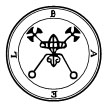|

|
| Bael |
Why Have So Many Humans Worshipped Bael?
By James Donahue
Ancient historical records indicate
that Bael, the first principal spirit listed in the Goetia, has been the subject of human worship for thousands of years.
The Hebrews were admonished in the Old
Testament for turning away from Jehova (an alien imposter) and bowing down to Bael. The Sumerians worshipped several gods,
including Marduk, another name for Bael, also called Baal. The Cannanites and Amorites also worshipped Bael. Some believe
the Egyptian god Osris was none other than Bael in disguise.
We suspect that this spirit, who seems
to have escaped Solomon's bindings even though he is named among the 72 Spirits of the Goetia, may still have bands of secret
worshippers bowing to him in clandestine places.
The irony of such behavior is that because
he is a spiritual entity and perhaps a creation of the very mind of men, Bael should not be in a position to be worshipped
by humans. Yet he appears to have been clever enough through to convince some of his deity and cause them to bow down to him.
He thus makes a mockery of human religious zeal.
His sigil, almost an image of a dancing
stick figure with extended crosses in both hands, portrays a prankster who enjoys misbehaving whenever the opportunity arises.
And the joke, for him, seems to be aimed at formal religion and all that practice it. Sad that the humans, who are the
victims of his tricks, fail to appreciated the humor behind his antics.
The old image of Bael, portrayed for
years after early summoners caught glimpses of three heads and what they thought were spidery legs, has been a close portrayal
of the way this spirit really appears. They said Bael has the heads of a man, a cat and a toad.

|
| Three Heads Of Bael |
Indeed, Bael is a three-headed and very
alien appearing entity emerging from an inverted crown. The crown is an indication of his title. He is a king.
There is a strange theory that Bael
or “Baal” was a name used by the Aztecs to refer to the Reptilians, a race of beings believed to have once existed
on this planet. Some believe the Reptilians are still among us.
The Canaanites, among the first in Europe
to worship Baal, perceived this entity as the son of El, the high god of Canaan. The very name Baal among the Canaanites meant
“lord” or “master.” The cult of Baal celebrated his death and resurrection as part of yearly fertility
rituals. The ceremonies often included human sacrifice.
The worship of Baal extended to the
Phoenicians and throughout the Mediterranean world to the Moabites and other tribes, including the Israelites. These people
worshipped Baal as a sun god, a cult worship which strangely appears to prevail even today in the Vatican.
Thus it is that Bael is perhaps the
most powerful and influencial of all of the 72 Spirits of the Goetia. He is the first on the list, and probably for good reason.
And he appears to still be having a major influence among the people of this planet.
According to S. L. MacGregor Mathers,
Bael is the King of the East and rules over 66 legions of spirits.
Bael may enjoy his jokes, but he is
not one to trust. There is no love of humanity reflected him.
It is commonly stated that when Bael
speaks, the voice is coarse, perhaps gravelly. He is said to have the power of invisibility. That is he can become invisible,
and perhaps make his summoner invisible upon request.

|
| Bael Sigil |
|

